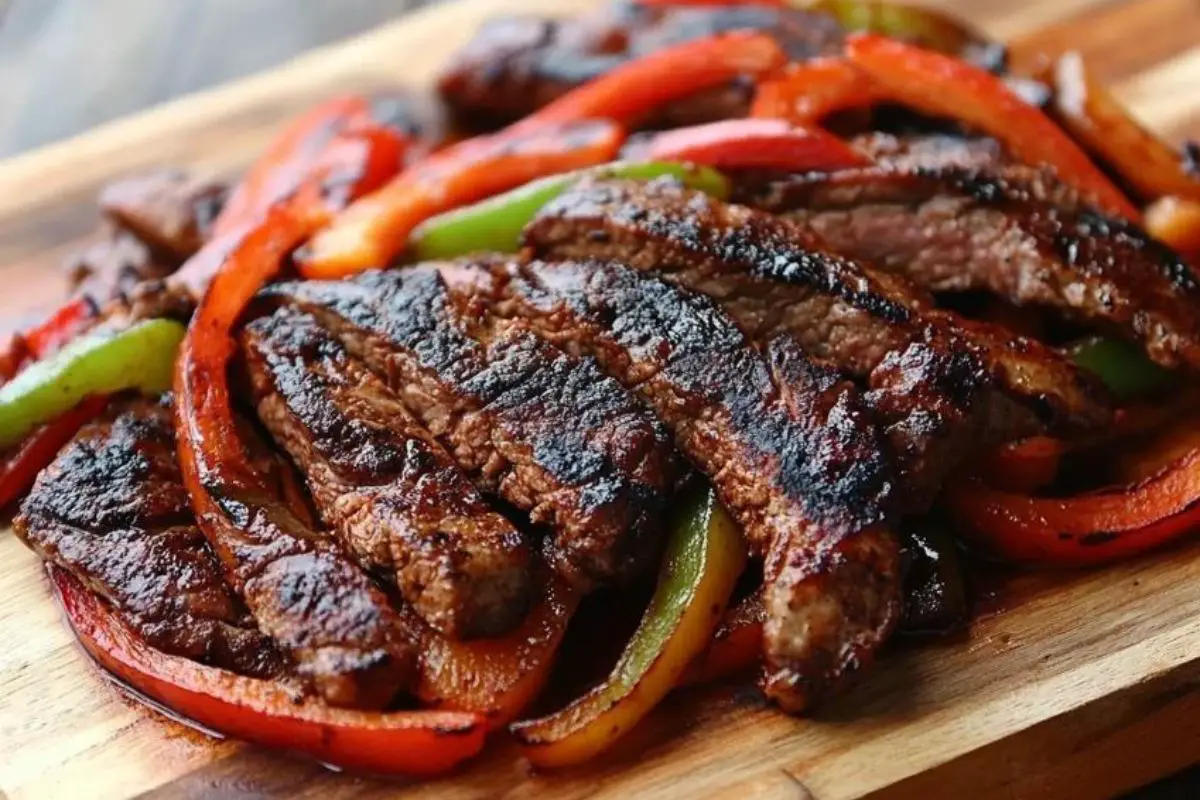When it comes to fajitas, the marinade is the secret sauce that turns simple grilled meats and veggies into a delicious Tex-Mex feast. Whether you’re making steak, chicken, shrimp, or even a plant-based option, a well-balanced marinade ensures every bite is infused with bold, tangy, and smoky flavors.
In this comprehensive guide, we’ll walk you through the essential components of a fajita marinade, tips for customizing your own, common mistakes to avoid, and how to cook perfectly marinated fajitas. We’ll also dive into variations, proper marinating techniques, and answer frequently asked questions. By the end, you’ll be equipped to make restaurant-quality fajitas at home.
What Is a Fajita Marinade?
At its core, a fajita marinade combines acid, fat, and seasonings to tenderize the meat and impart flavor. The acid breaks down the meat fibers, allowing the spices to penetrate deeply, while the fat keeps the meat moist during cooking.
The balance of these elements is key:
- Acid: Typically, lime juice, vinegar, or other citrus juices. Acid is essential for breaking down tough muscle fibers and enhancing flavor.
- Fat: Usually oil (olive oil, vegetable oil), which helps distribute the spices evenly and prevents the meat from drying out.
- Spices and Aromatics: This includes garlic, onion, cumin, chili powder, paprika, cilantro, and sometimes more exotic spices like chipotle or smoked paprika for a deeper flavor profile.
These three elements combine to create the unmistakable taste of a fajita, making each bite juicy, tender, and packed with flavor.
For an in-depth explanation on how marinades work, check out Serious Eats’ article on marinades.
The Role of Acid in Marinating
Acid plays a crucial role in marinating by helping to tenderize meat and enhance flavor. Here’s how it works:
Tenderizing Meat
- Breaks down proteins: Acids like vinegar, lemon juice, or yogurt denature proteins in the meat, unraveling them and making the texture softer. This is especially helpful for tougher cuts, like skirt steak or chicken breast.
- Collagen breakdown: Acid can partially break down collagen, the connective tissue in meat, making it more tender. However, too much acid or over-marinating can turn the meat mushy by breaking down too much structure.
Flavor Enhancement
- Deepens flavor: Acids infuse the meat with tanginess and balance, intensifying the flavors of other marinade ingredients like herbs, spices, or oils.
- Balances richness: Acid cuts through fatty meats, balancing the richness with a sharper taste, making dishes feel lighter and more refreshing.
Common Acidic Ingredients in Marinades
- Citrus juices: Lemon, lime, and orange juice add brightness and tang while tenderizing meat.
- Vinegars: Apple cider vinegar, balsamic, or red wine vinegar are often used for their sharp, distinctive flavors.
- Yogurt or buttermilk: These add a mild acidity and creamy texture, especially in marinades for chicken and lamb.
Important Tip: Marinating time is critical with acids. Shorter marinating times (30 minutes to a few hours) prevent over-tenderization, which can make the meat mushy rather than juicy and tender.
The Essential Components of a Fajita Marinade

To create a marinade that delivers the perfect balance of tangy, smoky, and spicy flavors, you need to master the key ingredients. Here’s what every good fajita marinade should include:
1. Citrus Juice (Acid)
Citrus juice, like lime or lemon, provides the tang that’s critical to a great fajita marinade. Lime juice is the most traditional option in Tex-Mex cooking, offering a bright, refreshing contrast to the spices. You could also substitute with vinegar (e.g., apple cider vinegar) for a sharper tang.
- Quantity: Use the juice of 3-4 limes for a batch that serves 4-6 people.
- Alternative Acids: Vinegar, orange juice, or even pineapple juice for a tropical twist.
2. Oil (Fat)
The fat in the marinade, usually olive oil or vegetable oil, helps to lock in moisture. It also allows the spices to stick to the meat and enhances the mouthfeel of the fajitas. The oil forms a protective coating, ensuring the meat stays juicy, even when cooked at high heat.
- Quantity: 1/4 cup of oil for every 1-1.5 lbs of meat.
- Best Oils: Olive oil, avocado oil, or any neutral-tasting oil.
3. Seasonings and Spices
The spices are where the magic happens. A blend of cumin, chili powder, garlic, and paprika gives fajitas their signature flavor. You can also add oregano, black pepper, or cayenne for extra heat.
- Chili Powder: Adds warmth and a touch of heat.
- Cumin: Earthy and warm, it’s a must-have for Tex-Mex flavors.
- Paprika: Adds mild smokiness and depth.
- Optional: Chipotle powder for heat and smokiness, or ground coriander for a floral touch.
Pro Tip: For even more flavor, toast the spices before adding them to the marinade. Toasting releases the essential oils in the spices, intensifying their flavor.
4. Aromatics
Fresh aromatics like garlic and onion add layers of flavor. Garlic, in particular, adds a pungent sweetness that complements the spices.
- Garlic: Mince 3-4 cloves for the perfect amount.
- Onion: You can use finely chopped onion in the marinade, or marinate sliced onions along with your meat to grill later.
5. Salt
Salt is vital for both flavor and for helping to tenderize the meat. It helps to draw out moisture from the meat and vegetables, which then mixes with the marinade, allowing the flavors to penetrate deeply.
- Quantity: 1-2 teaspoons of salt for every batch of marinade.
- Best Salt: Use kosher or sea salt for best results.
6. Sweeteners (Optional)
If you prefer a slight sweetness to balance out the heat and acidity, you can add a touch of honey, brown sugar, or agave syrup. This is especially useful when grilling, as the sugars caramelize on the surface, creating a delicious crust.
- Honey: Adds mild sweetness and helps balance the lime’s acidity.
- Brown Sugar: Adds a deeper molasses-like sweetness.
7. Optional Add-ins
When creating delicious fajitas, you can elevate your dish with various optional add-ins. Here are some tasty suggestions to consider:
1. Vegetables
- Bell Peppers: Use a mix of red, yellow, and green bell peppers for color and sweetness.
- Onions: Slice onions (yellow or red) to add sweetness and depth.
- Mushrooms: Add sliced mushrooms for an earthy flavor that pairs well with other fajita ingredients.
- Zucchini: Grilled zucchini can add a fresh texture and subtle flavor.
- Corn: Grilled or roasted corn adds sweetness and a bit of crunch.
2. Fresh Herbs
- Cilantro: Chopped fresh cilantro brightens the flavors and adds a fresh touch.
- Green Onions: Sliced green onions add a mild onion flavor and a pop of color.
- Parsley: For a different herbaceous note, chopped parsley can be a nice addition.
3. Cheese
- Cheddar Cheese: Shredded cheddar cheese melts beautifully over hot fajitas.
- Queso Fresco: This crumbly cheese adds a fresh, creamy texture.
- Pepper Jack Cheese: For those who like a bit of spice, pepper jack cheese adds flavor and heat.
4. Sauces and Condiments
- Guacamole: Creamy guacamole provides richness and balances spicy flavors.
- Sour Cream: A dollop of sour cream adds creaminess and tanginess.
- Salsa: Fresh salsa or pico de gallo can enhance the fajitas with fresh, zesty flavors.
- Hot Sauce: For extra heat, a few dashes of your favorite hot sauce can spice things up.
5. Tortillas
- Flour Tortillas: Soft flour tortillas are classic for fajitas.
- Corn Tortillas: For a gluten-free option, corn tortillas work great.
- Whole Wheat Tortillas: A healthier alternative with added fiber.
6. Avocado
- Sliced Avocado: Adds creaminess and a rich flavor to your fajitas.
7. Sides
- Rice: Serve with Mexican rice or cilantro lime rice for a hearty meal.
- Beans: Black beans or refried beans can be a filling side option.
- Salad: A light salad can complement the fajitas and balance the meal.
8. Seasoning Boosters
- Lime Zest: A bit of lime zest in the marinade or as a garnish can brighten the flavors.
- Cumin and Paprika: Additional spices can enhance the overall flavor profile of the fajitas.
These optional add-ins not only enhance the flavor and texture of your fajitas but also allow for customization based on personal preferences and dietary needs. Feel free to mix and match to create your perfect fajita!
How Long to Marinate Fajita Meat

Step-by-Step Guide to Making the Perfect Fajita Marinade
Step 1: Gather Your Ingredients
To start, you’ll need:
- Juice of 3-4 limes
- 1/4 cup of olive or vegetable oil
- 2-3 cloves of garlic, minced
- 1 tablespoon of chili powder
- 1 teaspoon of cumin
- 1 teaspoon of paprika
- 1 teaspoon of salt
- Optional: honey, fresh cilantro, and cayenne pepper for heat
Step 2: Mix the Marinade
In a medium bowl, whisk together all the ingredients until fully combined. Taste the marinade and adjust the seasoning, adding more lime juice for tang, honey for sweetness, or spices for heat.
Step 3: Marinate the Meat
Place your protein (chicken, steak, shrimp, or vegetables) into a large ziplock bag or glass container. Pour the marinade over the protein, ensuring it’s fully coated. Seal the bag, pressing out any excess air, and refrigerate for the recommended marinating time.
Step 4: Cook Your Fajitas
When ready to cook, remove the protein from the marinade and let any excess drip off. Cook over high heat, whether you’re using a grill, stovetop, or even a cast-iron skillet. For best results, cook your fajitas quickly at high heat to achieve a nice sear on the outside while keeping the inside juicy.
Grill: Preheat to medium-high heat and cook chicken for 6-8 minutes per side, steak for 4-6 minutes per side, or shrimp for 2-3 minutes per side.
Skillet: Heat a cast-iron skillet over high heat and sear the meat until cooked to your desired doneness.
Fajita Marinade Variations
Here are some delicious fajita marinade variations that can enhance your fajita experience, offering a variety of flavors to suit different tastes:
1. Classic Fajita Marinade
- Ingredients: Lime juice, garlic, olive oil, cumin, chili powder, salt, and pepper.
- Flavor Profile: This traditional marinade delivers a bright, citrusy kick with earthy spices, ideal for beef or chicken.
2. Citrus and Garlic Marinade
- Ingredients: Lemon juice, lime juice, orange juice, garlic, cilantro, and jalapeños.
- Flavor Profile: A tangy and refreshing option that combines citrus with robust garlic flavors, perfect for shrimp or chicken.
3. Spicy Chipotle Marinade
- Ingredients: Chipotle peppers in adobo sauce, smoked paprika, cumin, garlic, lime juice, and olive oil.
- Flavor Profile: Smoky and spicy, this marinade is ideal for those who enjoy a bolder flavor.
4. Tequila Lime Marinade
- Ingredients: Tequila, lime juice, olive oil, garlic, chili powder, and cumin.
- Flavor Profile: Adds a unique depth with the distinct flavor of tequila, making it great for grilling.
5. Greek Yogurt Marinade
- Ingredients: Greek yogurt, lemon juice, garlic, oregano, and olive oil.
- Flavor Profile: Tenderizes the meat while adding creaminess and a mild tang, particularly good for chicken.
6. Soy Sauce and Honey Marinade
- Ingredients: Soy sauce, honey, lime juice, garlic, and ginger.
- Flavor Profile: A balance of salty and sweet that works well with beef fajitas, providing depth and flavor.
7. Cilantro Lime Marinade
- Ingredients: Fresh cilantro, lime juice, garlic, olive oil, and jalapeño.
- Flavor Profile: Bright and herby, perfect for chicken or shrimp, adding a refreshing taste.
8. Balsamic Fajita Marinade
- Ingredients: Balsamic vinegar, olive oil, garlic, rosemary, salt, and pepper.
- Flavor Profile: Sweet and tangy, this marinade is excellent for steak fajitas.
9. Honey Mustard Marinade
- Ingredients: Honey, Dijon mustard, lime juice, olive oil, and garlic.
- Flavor Profile: A sweet-savory combination that’s particularly good with chicken.
10. Jerk Marinade
- Ingredients: Allspice, thyme, Scotch bonnet peppers, garlic, lime juice, and soy sauce.
- Flavor Profile: Spicy and aromatic, offering a vibrant flavor for chicken or beef.
Using Marinades Effectively

- Timing: Generally, allow meats to marinate for at least 30 minutes and up to 24 hours, depending on the marinade’s acidity.
- Safety: Always marinate in the refrigerator and discard leftover marinade that has touched raw meat to avoid foodborne illness.
For more detailed recipes and variations, you can refer to these resources:
Print
fajita marinade
Description
Assorted fajita marinades in bowls with fresh ingredients like lime, garlic, and cilantro, perfect for grilling fajitas.
Ingredients
To start, you’ll need:
- Juice of 3–4 limes
- 1/4 cup of olive or vegetable oil
- 2–3 cloves of garlic, minced
- 1 tablespoon of chili powder
- 1 teaspoon of cumin
- 1 teaspoon of paprika
- 1 teaspoon of salt
- Optional: honey, fresh cilantro, and cayenne pepper for heat
Instructions
Making the perfect fajita marinade involves using a blend of essential ingredients. Here’s a quick rundown of what you need:
- Citrus juice (lime or lemon): Provides the necessary acidity to break down tough fibers in meat.
- Oil (olive oil or vegetable oil): Helps the spices adhere to the meat while keeping it tender and moist.
- Garlic: A key flavor component that complements the spices.
- Cumin: Adds a rich, earthy flavor typical of Tex-Mex cuisine.
- Chili powder: For the classic fajita heat.
- Paprika: Adds a smoky element without overpowering the other flavors.
- Optional Ingredients: Soy sauce for a salty umami kick, cilantro for freshness, or honey for a touch of sweetness.
Notes
A good fajita marinade typically contains a balance of acid, oil, and spices. The acid helps tenderize the meat by breaking down the proteins, while the oil locks in moisture, keeping the meat juicy during cooking. The spices create that distinctive fajita flavor.

